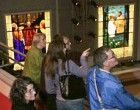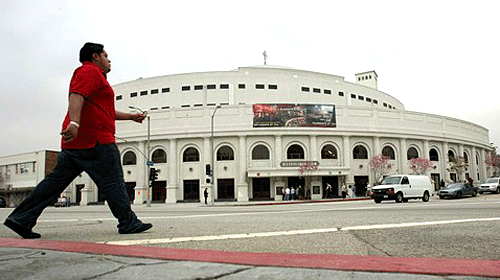



Photo: The Angelus Temple in Echo Park could hold 5,300 people when it was completed in 1923 at the direction of evangelist Aimee Semple McPherson.
'City of Seekers' shows a common thread among five locations, including
the Self-Realization Fellowship Mother Center and
the Angelus Temple, that contributed to the region's spiritual traditions.
In the quiet gardens of the Self-Realization Fellowship Mother Center, the monastics
like to tell the sweet story of the swami, the horticulturist and the cactus.
That parable-like tale -- which we'll get to in just a bit -- was one of the many
discoveries during "City of the Seekers," a tour of spiritual locations
organized this month by the Los Angeles
Conservancy.
Subtitled "L.A.'s Unique Spiritual Legacy," the tour featured five venues
that contributed to the spiritual traditions of the region. As the main title suggested,
it was all about people seeking something beyond themselves.
In addition to seeing the fellowship on Mount Washington, people who took the driving tour
visited the Chapel of Jesus Ethic in Glendale, the Philosophical Research Society in Los
Feliz, the Bonnie Brae House in Historic Filipinotown and one of the most recognizable
religious buildings in Los Angeles: the domed Angelus Temple in Echo Park.
In a printed guide to the tour, Trudi Sandmeier, director of education for the
conservancy, wrote, "As our 'City of Seekers' tour illustrates, our built environment
is rich in historic religious sites, both traditional and nontraditional."
The Self-Realization
Fellowship would fall in the latter category. The organization was founded in 1920 by
Paramahansa Yogananda, an Indian swami who introduced America to yoga and gained a
worldwide following with his "Autobiography of a Yogi."
It's said that Yogananda had a vision of the Mount Washington site, which offers
commanding views of downtown Los Angeles. As docents explained, the Mount Washington Hotel
opened there in 1910 and was connected to the flatlands 940 feet below by an incline
railway that was dismantled long ago. In 1925 the Mission Revival-style hotel was
purchased by Yogananda, who made the site his headquarters. It remains a center for study
and meditation. As one of the docents explained, pointing to parts of the complex,
"Nuns to the right; monks to the left."
The rich and famous were among Yogananda's friends, including conductor Leopold Stokowski
and famed horticulturist Luther Burbank. Which brings us to the cactus. As the story goes,
Burbank talked lovingly to a cactus, so reassuring and calming that the plant dropped its
needles. A cutting from the cactus was planted at the Self-Realization Fellowship and
still flourishes, free of spines. Yogananda blended Eastern traditions, such as breath
control, with Christianity. Indeed, visitors to the center's library could see another of
his many books, "The Yoga of Jesus," whose cover depicts Jesus sitting in a
lotus position.
To the west, across the street from the Glendale Galleria, the Chapel of Jesus Ethic
offered another example of religious synthesis. The building, with a sweeping roof and
lots of windows, is an example of the Modern design school popular in the 1960s. A garden
is based on a garden found at Yogananda's fellowship.
The complex was built as the centerpiece for the Ann
Ree Colton Foundation of Niscience (pronounced NISH-ence), which also blends
Christianity with Eastern belief systems and practices, such as meditation. Founded by
Colton, who died in 1984 two months shy of her 86th birthday, the foundation also places a
premium on the creative arts. The conservancy's tour booklet offered this striking
anecdote:
"It was while conducting worship services in the Chapel of the Jesus Ethic on Aug.
12, 1973, that Colton experienced what is described by her followers as a levitation
miracle. At this moment, as witnessed by those in the congregation, her body rose into the
air and turned over, landing on her back a short distance down the aisle from her original
position. She explained that this phenomenon was the power of Christ overtaking her body
to demonstrate his physical and spiritual power."
A short drive away was yet another example of how Angelenos have blended traditions and
schools of thought.
The Philosophical Research Society, near Griffith Park,
was the headquarters of Manly P. Hall, who over six decades wrote more than 200 books on
philosophy and spiritual practices. His best-known work was the modestly titled "The
Secret Teachings of All Ages: An Encyclopedic Outline of Masonic, Hermetic, Qabbalistic
and Rosicrucian Symbolical Philosophy."
The headquarters is a visual encyclopedia of sorts. It was built in Mayan Revival style,
but the carved wooden doors to the library feature Confucius and Plato. Statues are
modeled on designs from ancient Egypt. Embedded in the courtyard is a bit of tile from Glastonbury Abbey in England, thought by some
to be the burial site of King Arthur.
The next two sites on the tour reflected sweeping movements of Christianity.
The Bonnie Brae House west of downtown is a simple cream-colored wood house surrounded by
modest homes and apartments. It may not look like much, but this was where the modern
Pentecostal movement was born in 1906. Tradition holds that William J. Seymour and some
fellow worshipers there were overtaken by the Holy Spirit and began speaking in tongues.
This led to the movement that became known as the Azusa Street Revival. The
porch of the house once collapsed under the weight of worshipers.
By contrast, the Angelus Temple could hold
5,300 people when completed in 1923 at the direction of evangelist Aimee Semple McPherson.
The building, a blend of vaguely classical columns and arches contrasted with art deco
rectangles, looms over Echo Park. Inside visitors gawked at the two balconies and the
30-foot windows designed by "Sister Aimee."
By mid-afternoon, a rock band set up in the sanctuary and began to practice -- loudly --
for a service geared toward a young audience. The tour-takers, who were old enough to have
annoyed their own parents by cranking up Rolling Stones albums, could not stand the volume
for long and left the sanctuary. But, in a sense, the band was just doing what worshipers
did there generations ago, though at a lower decibel level. They were seeking something as
well.
That's what tied Angelus Temple to the other tour venues. Like that cactus at the swami's
retreat, many people are looking for a safe place to grow, a place where there's no need
for spines.
steve.padilla@latimes.com
Source: http://www.latimes.com/news/local/la-me-beliefs23-2009mar23,0,7400915.story